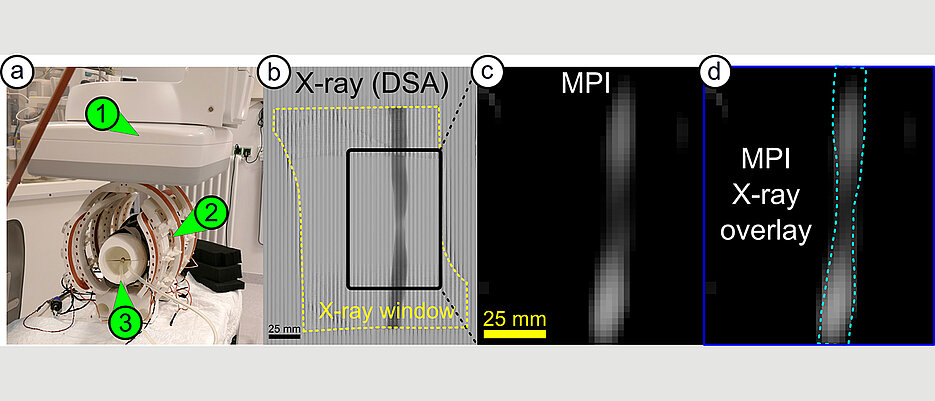A quick look inside a human being

The iMPI scanner is so small and light that you can take it with you and use it almost anywhere. This is a first important step towards radiation-free intervention.
(c) Patrick Vogel / Stefan Herz / University of Wuerzburg
Physicists at the University of Würzburg have succeeded in making a new imaging technique ready for use on humans. Radioactive markers and radiation are not necessary for this.
Imaging techniques such as computed tomography, magnetic resonance imaging, positron emission tomography and ultrasound have become indispensable in the medical world. Each method not only opens up unique insights into the inside of people, but also allows physicians to draw conclusions about defects or functional processes in the human body.
A team of physicists and medical doctors from the Julius-Maximilians-Universität Würzburg (JMU) has now succeeded in making another – and radiation-free – imaging technology ready for use on humans. Its name: Magnetic Particle Imaging (MPI). With the portable scanner they developed, it is possible, among other things, to visualise dynamic processes in the human body, such as the blood flow.
Professor Volker Behr and Dr. Patrick Vogel from the University’s Institute of Physics are responsible for this study; they have now published the results in the journal Nature Scientific Reports.
A sensitive and fast alternative
Magnetic particle imaging is a technique based, as the name suggests, on the direct visualisation of magnetic nanoparticles. Such nanoparticles do not occur naturally in the human body and must be administered as markers. “As with positron emission tomography, which relies on the administration of radioactive substances as markers, this method has the great advantage of being sensitive and fast without ‘seeing’ interfering background signals from tissue or bone,” explains Volker Behr.
 The iMPI scanner (left) provides new insights into the human body. Here you can see a constriction in a blood vessel – recorded with conventional X-rays (b), with the scanner (c) and in a combination of both techniques (d). (Image: Patrick Vogel / Stefan Herz)
The iMPI scanner (left) provides new insights into the human body. Here you can see a constriction in a blood vessel – recorded with conventional X-rays (b), with the scanner (c) and in a combination of both techniques (d). (Image: Patrick Vogel / Stefan Herz)MPI is not based on the detection of gamma rays from a radioactive marker like positron emission tomography, but on the response signal of the magnetic nanoparticles to magnetic fields that change over time. “In this process, the magnetisation of nanoparticles is specifically manipulated with the help of external magnetic fields, whereby not only their presence but also their spatial position in the human body can be detected,” says physicist Patrick Vogel, first author of the publication.
A small scanner for big insights
The MPI idea is not new. As early as 2005, the Philips company was able to show the first images of this novel approach in a small demonstrator, which, however, could only take samples a few centimetres in size. And the development of devices suitable for examining humans proved more difficult than expected, leading to large, heavy and expensive constructions.
In 2018, the team led by Professor Volker Behr and Patrick Vogel found a new way to implement the complex magnetic fields required for imaging in a much smaller design. In a multi-year research project funded by the German Research Foundation (DFG), the scientists succeeded in implementing the novel concept in an MPI scanner (interventional Magnetic Particle Imaging – iMPI) specifically designed for intervention.
“Our iMPI scanner is so small and light that you can take it almost anywhere,” Vogel explains. The authors impressively demonstrate this mobility of the scanner in a simultaneous real-time measurement in comparison with a special X-ray device, which is the standard device in angiography in university hospitals. The team led by Professor Thorsten Bley and Dr. Stefan Herz of the Interventional Radiology Department of the Würzburg University Hospital, which accompanied this project from the beginning, carried out the measurements on a realistic vascular phantom and evaluated the first images.
“This is a first important step towards radiation-free intervention. MPI has the potential to change this field for good,” said Dr Stefan Herz, senior author of the publication.
Next steps in research
In addition to further exciting measurements with the iMPI device, the two physicists are now working on further developing their scanner. The main goal is to further improve the image quality.
Wissenschaftliche Ansprechpartner:
Prof. Dr. Volker Behr, Experimental Physics 5, University of Würzburg, T + 49 931 31-85766, volker.behr@uni-wuerzburg.de
Dr. Patrick Vogel, Experimental Physics 5, University of Würzburg, T + 49 931 31-88509, patrick.vogel@uni-wuerzburg.de
Originalpublikation:
P. Vogel et al, ” iMPI: portable human-sized magnetic particle imaging scanner for real-time endovascular interventions “, Nature Scientific Reports, 13, 10472, 2023, https://doi.org/10.1038/s41598-023-37351-2
All latest news from the category: Medical Engineering
The development of medical equipment, products and technical procedures is characterized by high research and development costs in a variety of fields related to the study of human medicine.
innovations-report provides informative and stimulating reports and articles on topics ranging from imaging processes, cell and tissue techniques, optical techniques, implants, orthopedic aids, clinical and medical office equipment, dialysis systems and x-ray/radiation monitoring devices to endoscopy, ultrasound, surgical techniques, and dental materials.
Newest articles

Pinpointing hydrogen isotopes in titanium hydride nanofilms
Although it is the smallest and lightest atom, hydrogen can have a big impact by infiltrating other materials and affecting their properties, such as superconductivity and metal-insulator-transitions. Now, researchers from…

A new way of entangling light and sound
For a wide variety of emerging quantum technologies, such as secure quantum communications and quantum computing, quantum entanglement is a prerequisite. Scientists at the Max-Planck-Institute for the Science of Light…

Telescope for NASA’s Roman Mission complete, delivered to Goddard
NASA’s Nancy Grace Roman Space Telescope is one giant step closer to unlocking the mysteries of the universe. The mission has now received its final major delivery: the Optical Telescope…



